Wideband Dynamic Monitoring and Control System for Power Systems with High Penetration of Renewable Energy and Power Electronics
Abstract
1. Introduction
- This paper systematically analyzes the key characteristics of WBOs and their impacts on equipment security and system stability, based on WBO events reported globally in recent years. It further highlights the inherent limitations of conventional monitoring systems in real-time analysis of wideband dynamics. The findings emphasize the importance of wideband monitoring for sustainable power system operation.
- A novel framework of the wideband dynamic monitoring and control system (WDMCS) is proposed, with a detailed description of its core components: wideband dynamic measurement and control unit (WDMCU), wideband dynamic data concentrator (WDDC), and the wideband dynamic analysis and control center (WDACC).
- A demonstration of WDMCS has been developed, and its effectiveness has been validated through hardware-in-the-loop (HIL) testing. In addition, based on the real-world application experience in China, this paper discusses the potential of the proposed WDMCS for broader deployment in future power systems. The practical implications of this system support the long-term sustainability of energy infrastructure.
2. Characteristics and Consequences of Wideband Oscillations
- WBOs are associated with power electronics control, exhibiting a broad frequency range, multiple dominant modes, and frequency coupling effects. For example, the Zhangbei flexible DC grid in China (four ±500 kV converter stations, 4.5 GW total capacity and over 2 GW renewable integration) experienced several WBO incidents between 2020 and 2022. These included SSOs (2–5 Hz) due to interactions between the Mijiagou wind farm and the DC system, high-frequency oscillations at the Zhongdu converter station (1000 Hz) and the Kangbanuoer converter station (700–1500 Hz), and near-fundamental-frequency oscillations (44/56 Hz) at Kangbanuoer.
- WBO characteristics are highly sensitive to the operational conditions of power systems, resulting in significant time-varying oscillation frequency. For example, during a 2022 event at the Yangjiang offshore wind farm in Guangdong, China (planned capacity of 2 GW), oscillation frequencies fluctuated between 977 Hz and 1328 Hz within three minutes. Oscillation current amplitudes exceeded the fundamental, leading to drop-out of wind turbines.
- Equipment damage: WBOs induce mechanical and electrical stresses that accelerate aging and failure of critical equipment such as transformers and power electronic converters. For example, chopper resistors of several DFIGs were damaged during the oscillation event in Zhangbei system [35], as shown in Figure 2a. Similarly, the Texas event damaged crowbar circuits and DC bus capacitors in wind turbines [36]. Oscillations in a wind farm in the North Sea, Germany, caused severe failures in filter capacitors and transformers [30].
- Equipment disconnections: WBOs can trip renewable generation units and power electronic devices. For example, an event in Guyuan, China, led to the disconnection of thousands of wind turbines [37], as shown in Figure 2c. A similar event in the Yunnan DC transmission project resulted in the shutdown of a static synchronous compensator (STATCOM) [38]. In Victoria, Australia, oscillations led to the tripping of multiple wind farms [39].
- Widespread system stability issues: WBOs can propagate through transmission networks, endangering distant power stations. In Hami, Xinjiang, China, SSOs originating from a wind farm caused torsional vibrations and forced the shutdown of thermal power plants hundreds of kilometers away, resulting in a significant frequency drop [15]. Likewise, the Hornsea offshore wind farm tripped due to oscillations, contributing to a major blackout in the United Kingdom [40].
3. The Wideband Dynamic Monitoring and Control System
3.1. Wideband Dynamic Measurement and Control Unit
- Synchronized Data Acquisition: Multi-channel voltage and current signals are simultaneously sampled at a high rate (e.g., 12.8 kHz) using a GPS-synchronized clock, ensuring precise time alignment across all measurement points as mandated by [41].
- Wideband Phasor Measurement and Oscillation Assessment: Based on the acquired waveforms, the fundamental phasor as well as harmonic and inter-harmonic phasors across a wide frequency range are calculated. For example, an interpolated DFT algorithm can be employed to mitigate spectral leakage and the picket-fence effect while maintaining relatively low computational complexity. The calculation process can be represented as [43]:where s(n) is the sampled signal; w(n) is the window function; X(m) is the represents the DFT result; Nw is the length of the observation window; mk is the index of the local peak spectral line related to the kth oscillation component; , and represent the corrected amplitude, frequency, and phase, respectively. δ is the compensation parameters which can be calculated as:Furthermore, dynamic indices related to oscillation modes can be calculated, such as the oscillation damping ratio and oscillation power flow. Upon detection of an oscillation, the unit immediately triggers waveform recording and storage for post-event analysis which is similar to the fault recording function in protection relays.
- Data Packaging and Transmission: The computed time-aligned phasor data and oscillation metrics are packaged into frames compliant with standard communication protocols and transmitted uplink to the WDDC or directly to the WDACC for system-wide situational awareness.
3.2. Wideband Dynamic Data Concentrator
- Enhancing overall communication efficiency within the monitoring architecture.
- Ensuring data integrity and continuity during communication failures.
- Distributing localized control or emergency protection commands to renewable energy plants or substations, facilitating rapid, regional response to WBO events.
3.3. Wideband Dynamic Analysis and Control Center
3.3.1. Wideband State Estimation and Panoramic Visualization
3.3.2. Early Warning of Wideband Oscillations
3.3.3. Identification of Wideband Oscillation Sources
3.3.4. Wideband Oscillation Mitigation and Protection
4. Development and Tests of a Demonstration of WDMCS
4.1. Implementation of a Demonstration of WDMCS
- Incorporation of phasor data for harmonics and inter-harmonics, organized in descending order of amplitude.
- Modification of configuration frames to accommodate variable numbers of oscillation modes.
- Addition of command frames, enabling the WDACC to issue control and protection commands to WDMCUs.
- Support for communication among WDMCUs, WDDC, and WDACC.
4.2. The HIL Test Platform
4.3. Test Results
4.4. Applications and Challenges
4.4.1. Multi-Dimensional Stability Assessment of Power Systems
4.4.2. Synchro-Waveform Data Analytics and Transmission
- Developing adaptive transmission protocols that switch between minimal essential data reporting during steady-state conditions and high-resolution waveform streaming only during triggered oscillatory or fault events.
- Leveraging compressed sensing and sparse signal recovery techniques to reduce communication bandwidth while retaining critical dynamic information.
- Implementing communication-aware data prioritization, potentially over modern telecom infrastructures (e.g., MPLS-TE, OTN, or 5G network slicing), to ensure low-latency and high-reliability transmission for critical monitoring and control data.
4.4.3. Wide-Area Coordinated Control and Protection
- Fast and Accurate Measurement Techniques: Embedding advanced algorithms (e.g., predictor-based or iterative methods) in WDMCUs to enable rapid and precise estimation of oscillation parameters.
- Pre-Defined and Localized Control Strategies: Identifying high-risk oscillation scenarios through offline studies and embedding pre-calculated control actions into regional WDDCs or even local WDMCUs. These strategies can be triggered autonomously based on real-time measurements, significantly shortening control latency.
- Hybrid control architectures: Integrating fast local control loops with centralized supervisory optimization to balance responsiveness with global coordination. This approach ensures that critical oscillations are suppressed promptly while maintaining overall system stability.
4.4.4. Scalability and Communication Performance in Large-Scale Deployment
- Hierarchical Data Management: The tiered structure (WDMCU-WDDC-WDACC) enables distributed data processing and aggregation, reducing the burden on core communication links and minimizing latency in data consolidation.
- Adaptive Reporting Mechanisms: As mentioned before, the system employs state-dependent data transmission, drastically reducing network load during normal operation while ensuring high-resolution data availability during critical events.
- Modern Telecom Integration: Future work will explore integration with emerging technologies such as 5G network slicing, which can provide dedicated ultra-reliable low-latency communication channels for grid control applications.
4.4.5. Techno-Economic Analysis and Commercial Viability
- Hardware integration costs for WDMCUs incorporating wideband measurement and local analytics capabilities;
- Software licensing models for the WDACC platform, considering its extensibility to incorporate diverse wideband dynamic analysis and control functionalities;
- Deployment expenses related to communication infrastructure upgrades and system integration with existing utility systems.
5. Conclusions
- WBOs present a serious threat to the stability and security of power systems. These oscillations are highly sensitive to power electronic control and system operating conditions, and exhibit distinct characteristics such as a broad frequency range, multiple dominant modes, and time-varying amplitudes and frequencies. Existing monitoring systems are insufficient for monitoring and analyzing such complex dynamic behaviors in real time, which is critical to supporting the transition to sustainable power systems.
- The proposed WDMCS enables real-time monitoring of wideband voltage and current phasors across the power grid. By integrating this data, the system facilitates wideband state estimation, panoramic visualization, early warning and source identification of oscillations, as well as adaptive mitigation and emergency protection. These functions enhance the reliability and resilience of power systems with high renewable penetration, thereby supporting operational sustainability.
- The demonstration of WDMCS and its real-world applications in China have validated its feasibility and effectiveness. Moreover, the proposed WDMCS shows promising potential in multiple areas, such as multi-dimensional stability assessment, synchronized waveform and wide-area coordinated control. However, further research is needed to address challenges related to advanced data transmission and compression techniques, scalability for large-scale grid deployment, and commercial viability.
Author Contributions
Funding
Institutional Review Board Statement
Informed Consent Statement
Data Availability Statement
Conflicts of Interest
References
- Maza-Ortega, J.M.; Acha, E.; García, S.; Gómez-Expósito, A. Overview of power electronics technology and applications in power generation transmission and distribution. J. Modern Power Syst. Clean Energy 2017, 5, 499–514. [Google Scholar] [CrossRef]
- Shair, J.; Li, H.; Hu, J.; Xie, X. Power system stability issues, classifications and research prospects in the context of high-penetration of renewables and power electronics. Renew. Sustain. Energy Rev. 2021, 145, 111111. [Google Scholar] [CrossRef]
- Beza, M.; Bongiorno, M. Impact of converter control strategy on low- and high-frequency resonance interactions in power-electronic dominated systems. Int. J. Electr. Power Energy Syst. 2020, 120, 105978. [Google Scholar] [CrossRef]
- Yuan, X.; Hu, J.; Cheng, S. Multi-time scale dynamics in power electronics-dominated power systems. Front. Mech. Eng. 2017, 12, 303–311. [Google Scholar] [CrossRef]
- Chen, L.; Xie, X.; He, J.; Xu, T.; Xu, D.; Ma, N. Wideband oscillation monitoring in power systems with high-penetration of renewable energy sources and power electronics: A review. Renew. Sustain. Energy Rev. 2023, 175, 113–148. [Google Scholar] [CrossRef]
- Lu, X.; Xiang, W.; Lin, W.; Wen, J. Analysis of wideband oscillation of hybrid MMC interfacing weak ac power system. IEEE Trans. Emerg. Sel. Topics Power Electron. 2021, 9, 7408–7421. [Google Scholar] [CrossRef]
- Li, C.; Yang, Y.; Dragicevic, T.; Blaabjerg, F. A new perspective for relating virtual inertia with wideband oscillation of voltage in low-inertia DC microgrid. IEEE Trans. Ind. Electron. 2022, 69, 7029–7039. [Google Scholar] [CrossRef]
- Cheng, Y.; Fan, L.; Rose, J.; Huang, S.-H.; Schmall, J.; Wang, X. Real-world subsynchronous oscillation events in power grids with high penetrations of inverter-based resources. IEEE Trans. Power Syst. 2023, 38, 316–330. [Google Scholar] [CrossRef]
- Shair, J.; Xie, X.; Wang, L.; Liu, W.; He, J.; Liu, H. Overview of emerging subsynchronous oscillations in practical wind power systems. Renew. Sustain. Energy Rev. 2019, 99, 159–168. [Google Scholar] [CrossRef]
- Zou, C.; Rao, H.; Xu, S.; Li, Y.; Li, W.; Chen, J. Analysis of resonance between a VSC-HVDC converter and the AC grid. IEEE Trans. Power Electron. 2018, 33, 10157–10168. [Google Scholar] [CrossRef]
- Shair, J.; Xie, X.; Liu, W.; Li, X.; Li, H. Modeling and stability analysis methods for investigating subsynchronous control interaction in large-scale wind power systems. Renew. Sustain. Energy Rev. 2021, 135, 110420. [Google Scholar] [CrossRef]
- Varma, R.K.; Moharana, A. SSR in double-cage induction generator-based wind farm connected to series-compensated transmission line. IEEE Trans. Power Syst. 2013, 28, 2573–2583. [Google Scholar] [CrossRef]
- Wu, M.; Xie, L.; Cheng, L.; Sun, R. A study on the impact of wind farm spatial distribution on power system sub-synchronous oscillations. IEEE Trans. Power Syst. 2016, 31, 2154–2162. [Google Scholar] [CrossRef]
- Fan, L.; Zhu, C.; Miao, Z.; Hu, M. Modal analysis of a DFIG-based wind farm interfaced with a series compensated network. IEEE Trans. Energy Convers. 2011, 26, 1010–1020. [Google Scholar] [CrossRef]
- Liu, H.; Xie, X.; He, J.; Xu, T.; Yu, Z.; Wang, C. Subsynchronous interaction between direct-drive PMSG based wind farms and weak AC networks. IEEE Trans. Power Syst. 2017, 32, 4708–4720. [Google Scholar] [CrossRef]
- Phadke, A.G.; Bi, T. Phasor measurement units, WAMS, and their applications in protection and control of power systems. J. Modern Power Syst. Clean Energy 2018, 6, 619–629. [Google Scholar] [CrossRef]
- Meegahapola, L.G.; Bu, S.; Wadduwage, D.P.; Chung, C.Y.; Yu, X. Review on oscillatory stability in power grids with renewable energy sources: Monitoring, analysis, and control using synchrophasor technology. IEEE Trans. Ind. Electron. 2021, 68, 519–531. [Google Scholar] [CrossRef]
- Terzija, V.; Valverde, G.; Cai, D.; Regulski, P.; Madani, V.; Fitch, J. Wide-area monitoring, protection, and control of future electric power networks. Proc. IEEE 2011, 99, 80–93. [Google Scholar] [CrossRef]
- Schleif, F.R.; White, J.H. Damping for the northwest—Southwest tieline oscillations—An analog study. IEEE Trans. Power App. Syst. 1966, PAS-85, 1239–1247. [Google Scholar] [CrossRef]
- Ballance, J.W.; Goldberg, S. Subsynchronous resonance in series compensated transmission lines. IEEE Trans. Power App. Syst. 1973, PAS-92, 1649–1658. [Google Scholar] [CrossRef]
- Xie, X.; Xin, Y.; Xiao, J.; Wu, J.; Han, Y. WAMS applications in Chinese power systems. IEEE Power Energy Mag. 2006, 4, 54–63. [Google Scholar] [CrossRef]
- IEEE Subsynchronous Resonance Working Group. Countermeasures to subsynchronous resonance problems. IEEE Trans. Power App. Syst. 1980, PAS-99, 1810–1818. [Google Scholar] [CrossRef]
- Xie, X.; Wang, L.; Han, Y. Combined application of SEDC and GTSDC for SSR mitigation and its field tests. IEEE Trans. Power Syst. 2016, 31, 769–776. [Google Scholar] [CrossRef]
- Fan, L.; Miao, Z. Wind in weak grids: 4 Hz or 30 Hz oscillations? IEEE Trans. Power Syst. 2018, 33, 5803–5804. [Google Scholar] [CrossRef]
- Wang, X.; Taul, M.G.; Wu, H.; Liao, Y.; Blaabjerg, F.; Harnefors, L. Grid-synchronization stability of converter-based resources—An overview. IEEE Open J. Ind. Applicat. 2020, 1, 115–134. [Google Scholar] [CrossRef]
- Damas, R.N.; Son, Y.; Yoon, M.; Kim, S.-Y.; Choi, S. Subsynchronous oscillation and advanced analysis: A review. IEEE Access 2020, 8, 224020–224032. [Google Scholar] [CrossRef]
- Virulkar, V.B.; Gotmare, G.V. Sub-synchronous resonance in series compensated wind farm: A review. Renew. Sustain. Energy Rev. 2016, 55, 1010–1029. [Google Scholar] [CrossRef]
- Wang, L.; Xie, X.; Liu, H.; Zhan, Y.; He, J.; Wang, C. Review of emerging SSR/SSO issues and their classifications. J. Eng. 2017, 2017, 1666–1670. [Google Scholar] [CrossRef]
- Xie, P.; Yang, Y.; Li, L.; Lu, Q.; Zhang, F.; Zhou, B. Analysis of the near-fundamental-frequency oscillation in an actual renewable energy system transmitted through MTDC grid. In Proceedings of the 12th International Conference on Renewable Power Generation (RPG 2023), Shanghai, China, 14–15 October 2023; pp. 706–711. [Google Scholar]
- Buchhagen, C.; Rauscher, C.; Menze, A.; Jung, J. BorWin1—First experiences with harmonic interactions in converter dominated grids. In Proceedings of the International ETG Congress 2015; Die Energiewende—Blueprints for the New Energy Age, Bonn, Germany, 17–18 November 2015; pp. 1–7. [Google Scholar]
- Fan, L.; Miao, Z. An explanation of oscillations due to wind power plants weak grid interconnection. IEEE Trans. Sustain. Energy 2018, 9, 488–490. [Google Scholar] [CrossRef]
- Sun, J. Impedance-based stability criterion for grid-connected inverters. IEEE Trans. Power Electron. 2011, 26, 3075–3078. [Google Scholar] [CrossRef]
- Liu, H.; Sun, J. Voltage stability and control of offshore wind farms with AC collection and HVDC transmission. IEEE Trans. Emerg. Sel. Topics Power Electron. 2014, 2, 1181–1189. [Google Scholar] [CrossRef]
- Cheah-Mane, M.; Sainz, L.; Liang, J.; Jenkins, N.; Ugalde-Loo, C.E. Criterion for the electrical resonance stability of offshore wind power plants connected through HVDC links. IEEE Trans. Power Syst. 2017, 32, 4579–4589. [Google Scholar] [CrossRef]
- Li, H.; Shair, J.; Zhang, J.; Xie, X. Investigation of subsynchronous oscillation in a DFIG-based wind power plant connected to MTDC grid. IEEE Trans. Power Syst. 2023, 38, 3222–3231. [Google Scholar] [CrossRef]
- Adams, J.; Carter, C.; Huang, S.-H. ERCOT experience with Sub-synchronous Control Interaction and proposed remediation. In Proceedings of the PES T&D 2012, Orlando, FL, USA, 7–10 May 2012; pp. 1–5. [Google Scholar]
- Xie, X.; Zhang, X.; Liu, H.; Liu, H.; Li, Y.; Zhang, C. Characteristic analysis of subsynchronous resonance in practical wind farms connected to series-compensated transmissions. IEEE Trans. Energy Convers. 2017, 32, 1117–1126. [Google Scholar] [CrossRef]
- Shu, D.; Xie, X.; Rao, H.; Gao, X.; Jiang, Q.; Huang, Y. Sub- and super-synchronous interactions between STATCOMs and weak AC/DC transmissions with series compensations. IEEE Trans. Power Electron. 2018, 33, 7424–7437. [Google Scholar] [CrossRef]
- Arraño-Vargas, F.; Shen, Z.; Jiang, S.; Fletcher, J.; Konstantinou, G. Challenges and mitigation measures in power systems with high share of renewables-the Australian experience. Energies 2022, 15, 429. [Google Scholar] [CrossRef]
- Sun, D.; Cao, J.; Qian, Z.; Gao, L. Power stabilization strategy for grid-connected doubly-fed wind turbines under voltage-type sub-synchronous oscillation. IEEE Trans. Ind. Appl. 2025, 61, 4102–4114. [Google Scholar] [CrossRef]
- IEEE Std C37.118.1-2011; IEEE Standard for Synchrophasor Measurements for Power Systems. IEEE Standards Association: Piscataway, NJ, USA, 2011.
- Ma, N.; Xie, X.; Sun, Y.; Zhang, Y.; Li, Y.; Liu, P. Wide-area Monitoring and Analysis of Wide-band Oscillation in New-type Power Systems. In Proceedings of the 2022 China International Conference on Electricity Distribution, Changsha, China, 7–8 September 2022; pp. 345–349. [Google Scholar]
- Agrez, D. Weighted multipoint interpolated DFT to improve amplitude estimation of multifrequency signal. IEEE Trans. Instrum. Meas. 2002, 51, 287–292. [Google Scholar] [CrossRef]
- Xie, X.; Zhan, Y.; Liu, H.; Li, W.; Wu, C. Wide-area monitoring and early-warning of subsynchronous oscillation in power systems with high-penetration of renewables. Int. J. Elect. Power Energy Syst. 2019, 108, 31–39. [Google Scholar] [CrossRef]
- Xie, X.; Zhan, Y.; Shair, J.; Ka, Z.; Chang, X. Identifying the source of subsynchronous control interaction via wide-area monitoring of sub/super-synchronous power flows. IEEE Trans. Power Del. 2020, 35, 2177–2185. [Google Scholar] [CrossRef]
- Liu, H.; Xie, X.; Gao, X.; Liu, H.; Li, Y. Stability analysis of SSR in multiple wind farms connected to series-compensated systems using impedance network model. IEEE Trans. Power Syst. 2018, 33, 3118–3128. [Google Scholar] [CrossRef]
- Chen, L.; Min, Y.; Hu, W. An energy-based method for location of power system oscillation source. IEEE Trans. Power Syst. 2013, 28, 828–836. [Google Scholar] [CrossRef]
- Maslennikov, S.; Wang, B.; Litvinov, E. Dissipating energy flow method for locating the source of sustained oscillations. Int. J. Elec. Power 2017, 88, 55–62. [Google Scholar] [CrossRef]
- Estevez, P.G.; Maslennikov, S. Extension of the Complex Dissipating Energy Flow Method for Sub/Super-Synchronous Oscillation Source Location. IEEE Trans. Power Syst. 2025, in press. [Google Scholar] [CrossRef]
- Liu, C.; Li, B.; Zhang, Y.; Jiang, Q.; Liu, T. The LCC type DC grids forming method and fault ride-through strategy based on fault current limiters. Int. J. Electr. Power Energy Syst. 2025, 170, 110843. [Google Scholar] [CrossRef]
- Xie, X.; Liu, W.; Liu, H.; Du, Y.; Li, Y. A system-wide protection against unstable SSCI in series-compensated wind power systems. IEEE Trans. Power Del. 2018, 33, 3095–3104. [Google Scholar] [CrossRef]
- Man, J.; Chen, L.; Terzija, V.; Xie, X. Mitigating high-frequency resonance in MMC-HVDC systems using adaptive notch filters. IEEE Trans. Power Syst. 2022, 37, 2086–2096. [Google Scholar] [CrossRef]
- IEC 61508; Functional Safety of Electrical/Electronic/Programmable Electronic Safety-Related Systems. International Electrotechnical Commission: Geneva, Switzerland, 2010.
- IEEE Std C37.118.2-2024; IEEE Standard for Synchrophasor Data Transfer for Power Systems. IEEE Standards Association: Piscataway, NJ, USA, 2024.
- GB/T26865.2-2011; Power System Real-Time Dynamic Monitoring System—Part 2: Data Transfer Protocol. Standardization Administration of the People’s Republic of China: Beijing, China, 2011.
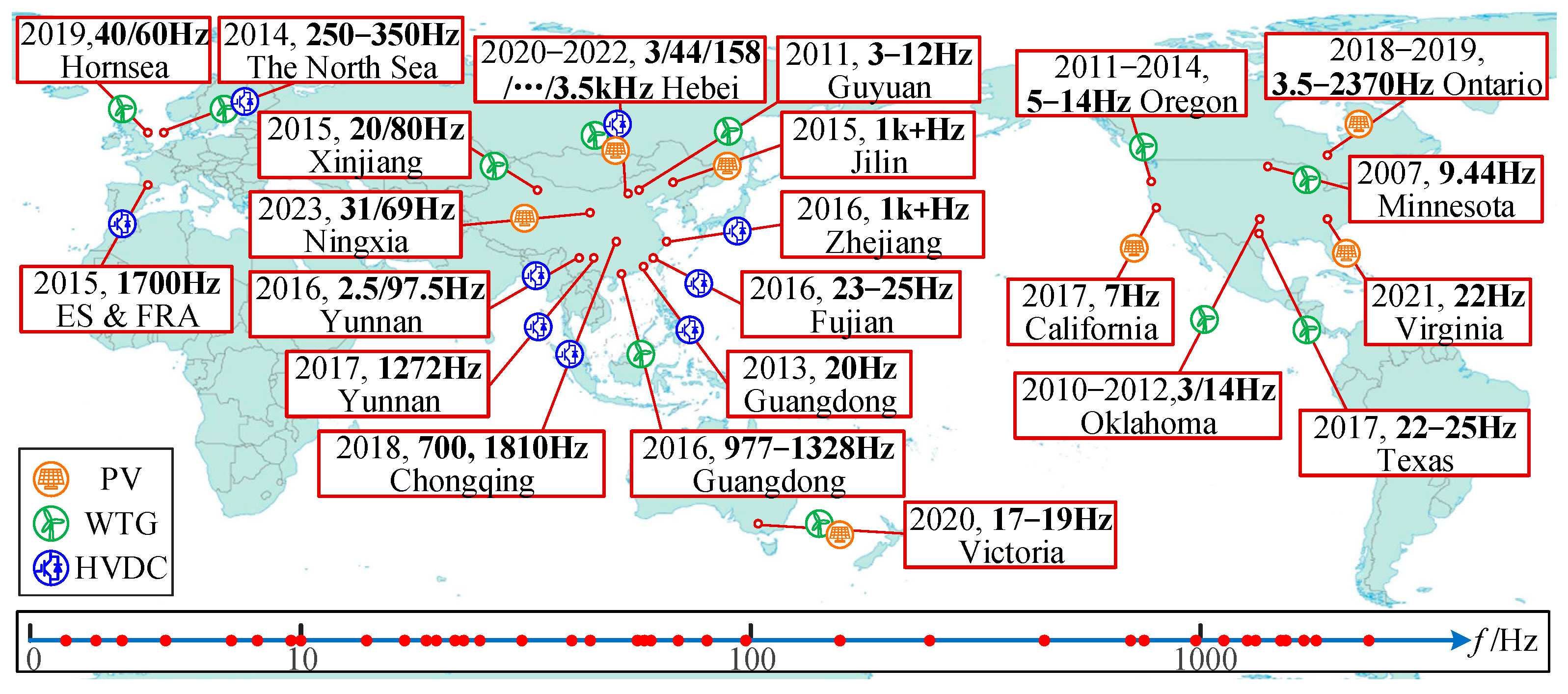

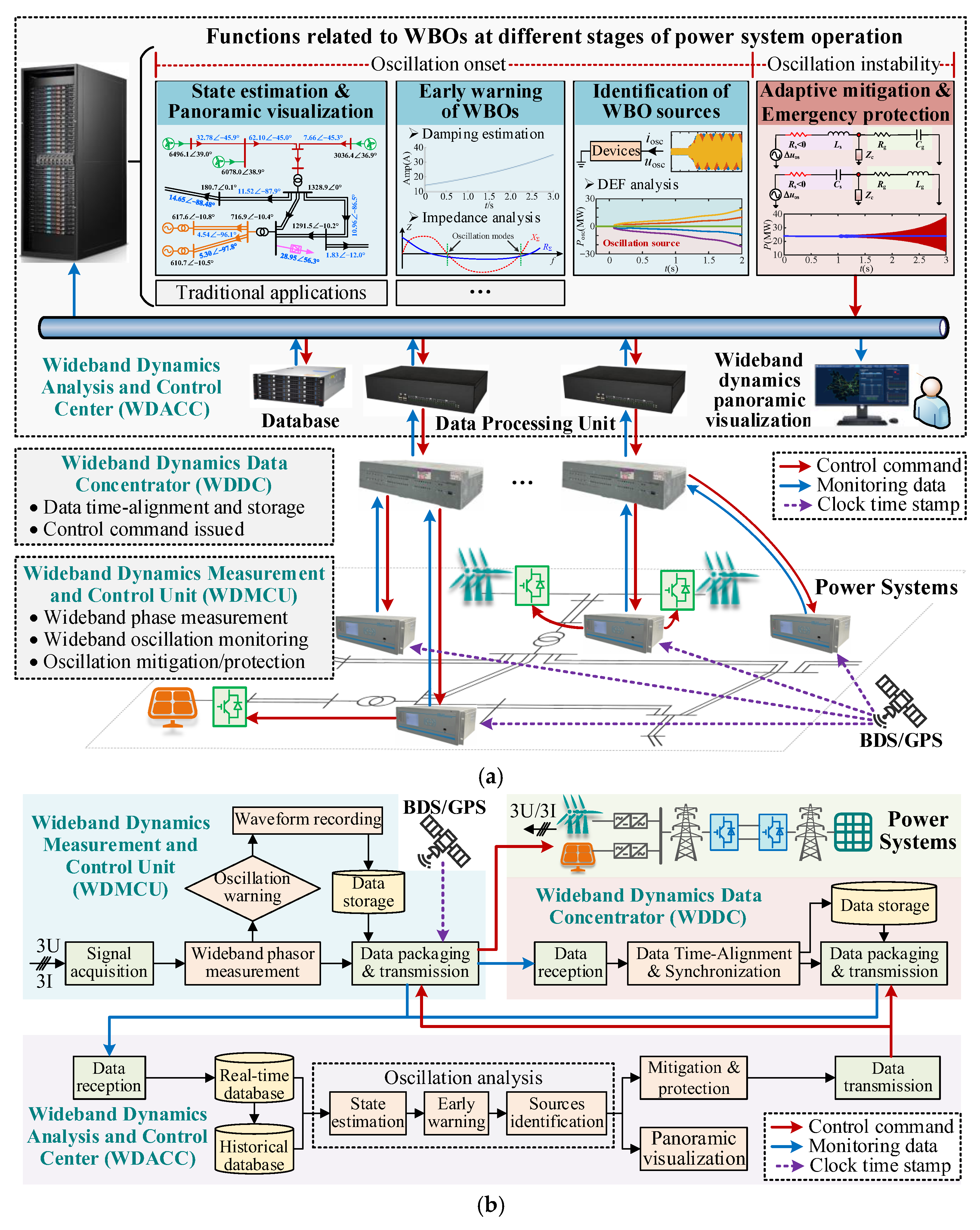
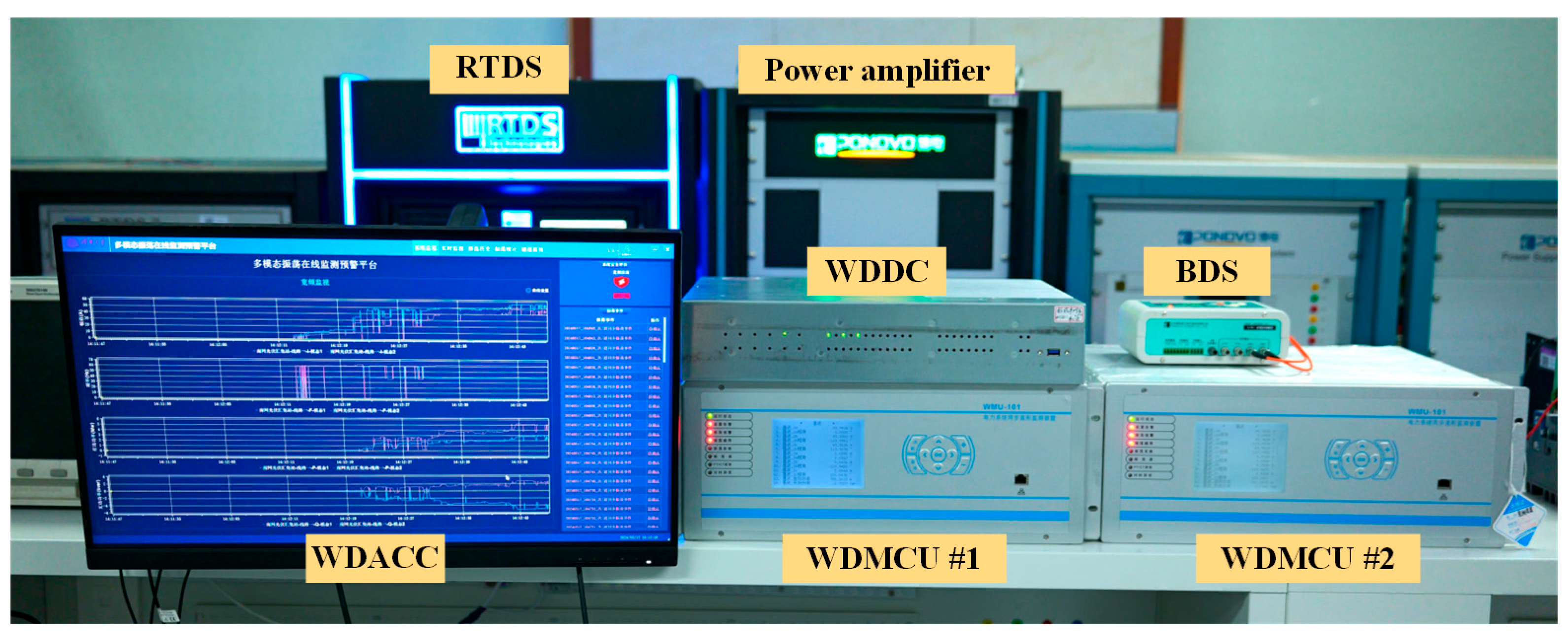
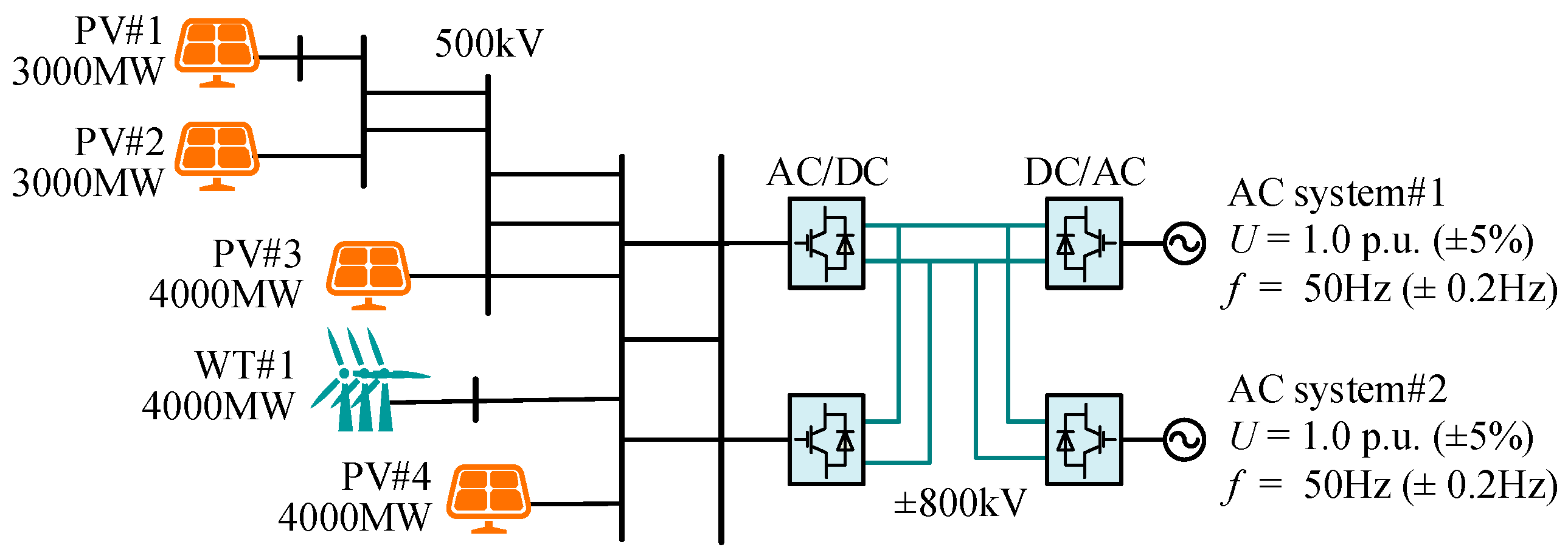
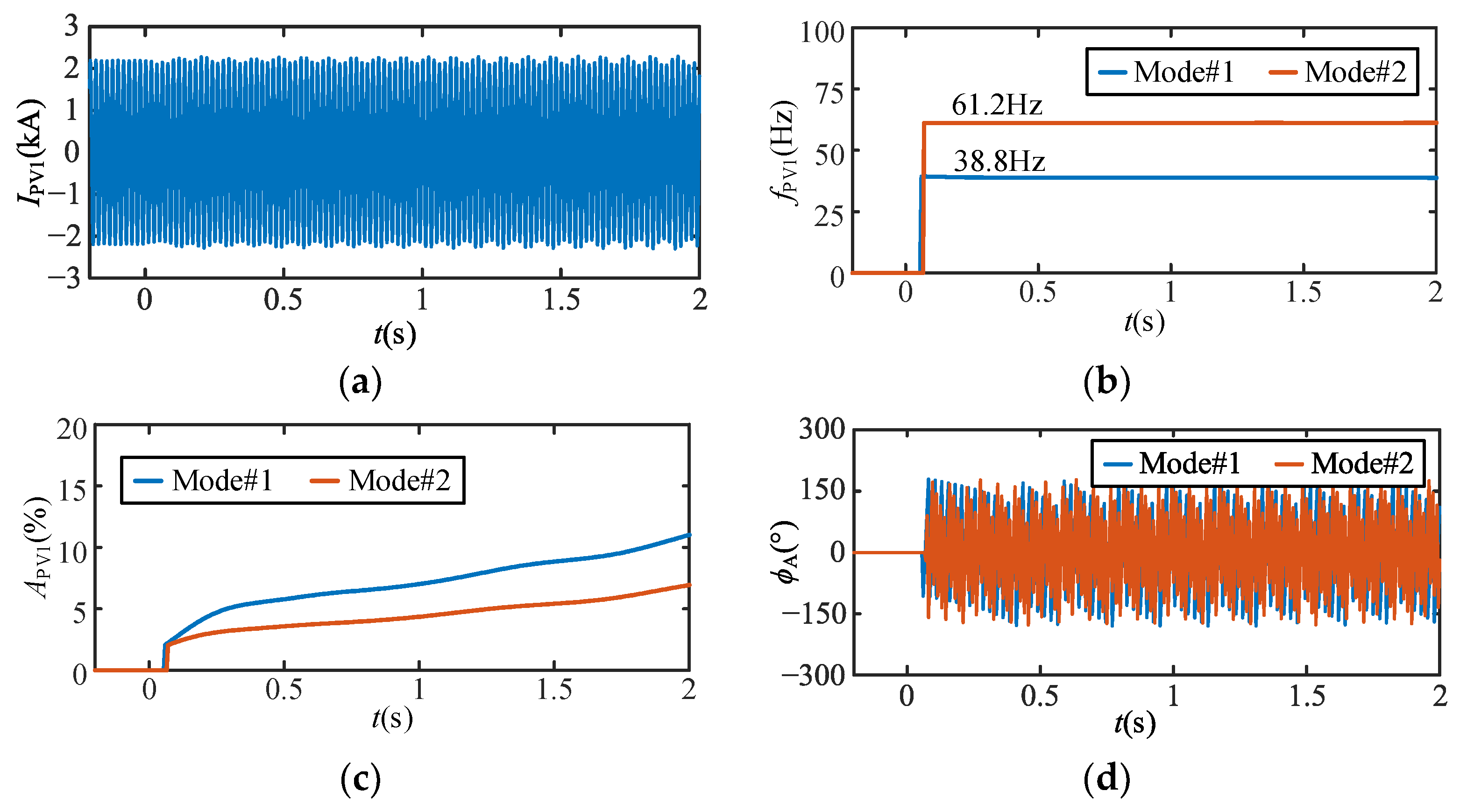


Disclaimer/Publisher’s Note: The statements, opinions and data contained in all publications are solely those of the individual author(s) and contributor(s) and not of MDPI and/or the editor(s). MDPI and/or the editor(s) disclaim responsibility for any injury to people or property resulting from any ideas, methods, instructions or products referred to in the content. |
© 2025 by the authors. Licensee MDPI, Basel, Switzerland. This article is an open access article distributed under the terms and conditions of the Creative Commons Attribution (CC BY) license (https://creativecommons.org/licenses/by/4.0/).
Share and Cite
Ma, N.; Xie, X.; Dong, W.; Li, H. Wideband Dynamic Monitoring and Control System for Power Systems with High Penetration of Renewable Energy and Power Electronics. Sustainability 2025, 17, 8334. https://doi.org/10.3390/su17188334
Ma N, Xie X, Dong W, Li H. Wideband Dynamic Monitoring and Control System for Power Systems with High Penetration of Renewable Energy and Power Electronics. Sustainability. 2025; 17(18):8334. https://doi.org/10.3390/su17188334
Chicago/Turabian StyleMa, Ningjia, Xiaorong Xie, Wenkai Dong, and Huawei Li. 2025. "Wideband Dynamic Monitoring and Control System for Power Systems with High Penetration of Renewable Energy and Power Electronics" Sustainability 17, no. 18: 8334. https://doi.org/10.3390/su17188334
APA StyleMa, N., Xie, X., Dong, W., & Li, H. (2025). Wideband Dynamic Monitoring and Control System for Power Systems with High Penetration of Renewable Energy and Power Electronics. Sustainability, 17(18), 8334. https://doi.org/10.3390/su17188334





